The amorous, exuberant George IV, when still Prince Regent, began building a retreat to suit his own fancy. The result was Brighton Pavilion, perhaps the most exotic extravaganza to survive time’s decay. ….
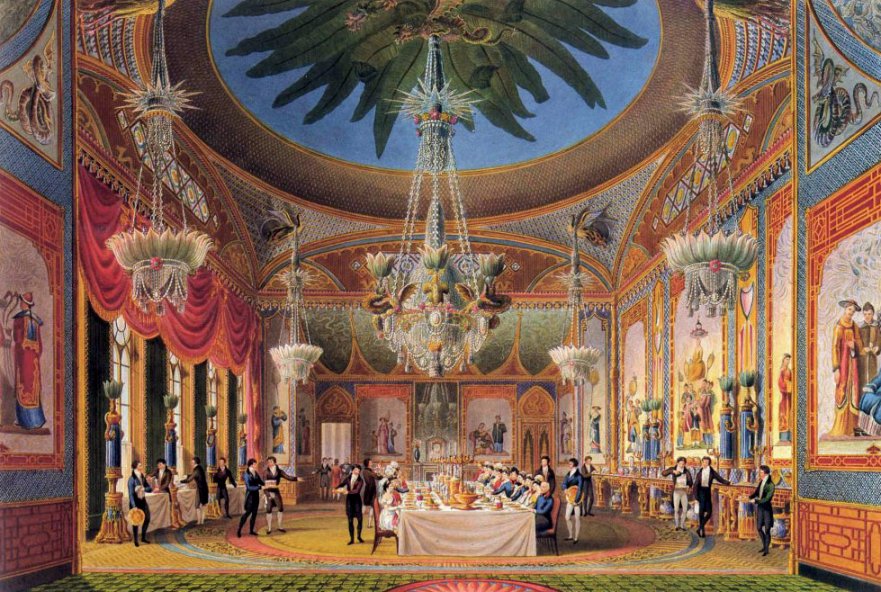
Although the Prince Regent put Brighton on the map as a fashionable place to be seen, its popularity had started to grow in the decades before. It was the advent of sea-bathing for medicinal purposes, that led to Brighton becoming a popular seaside resort. In 1750, Dr Richard Russell of Lewes published A Dissertation Concerning the Use of Sea Water in Diseases of the Glands and by 1754 had opened an establishment for medicinal cures in Hove. Bathing, fully clothed from bathing machines, was in the charge of bathing attendants, called 'dippers' for women and 'bathers' for men. By 1765, Brighton had become a popular resort for society. Dr Johnson, Fanny Burney and Mrs Thrale were among the early visitors.
Lying in the very heart of Brighton, close to the seashore but set back from it, is the fantasy of the Brighton Pavilion- with its domes and minarets, its fretwork tracery and lacelike embattlements; and underneath this Oriental masquerade , the fine proportions of Henry Holland’s classical villa, the first Pavilion, can still be discerned, as Georgian and as classical as any house in Brighton. It was built by the Prince Regent ( 1762-1830) , the eldest son of George III, and like the Prince the Pavilion grew more monstrous, more extraordinary, more dreamlike with the years. But first, why should the Pavilion be found in Brighton?

Rex Whistler:Allegory: H.R.H, the Prince Regent Awakening the Spirit of Brighton, 1944. Courtesy Royal Pavilion, Libraries & Museums, Brighton Recalling William Etty’s Sleeping Nymphs and Satyrs, the notoriously profligate Prince is seen naked but for a fluttering sash, leaning over the sleeping ingénue of the city.
Three hundred years ago, Brighton scarcely existed. It was excellent country for the horse, for riding it, racing it, or driving it. And that later, was one of the reasons for Brighton’s popularity, for many of the Prince’s friends were crazed about horses as only the English aristocracy can be. But Brighton first grew to fame and fashion through the salesmanship of a successful doctor. He sold sea water. Its virtues said Dr. Russell, whether applied externally or internally, were boundless. A cold dip , it seemed, proved peculiarly efficacious to that feminine frailty of the age of elegance- the vapors- so long as it was taken at hideously appropriate times: Fanny Burney, the novelist, bathed in November before dawn, a very good time, the doctors thought. Also, as might be expected, sea-bathing or sea drinking encourage fertility in young matrons. “better even,” said its advocates, “than the mud of the river Nile.”
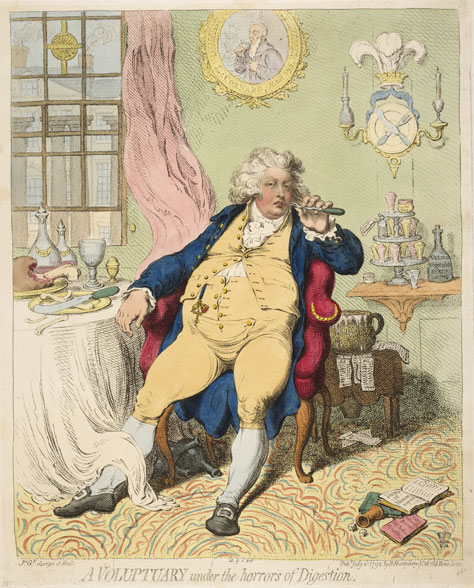
---Here Gillray portrays George, Prince of Wales, later Prince Regent and George IV (reigned 1820-1830), picking his teeth with a table fork, having demolished a heavy meal and a considerable quantity of wine. The Prince was notoriously dissolute and spendthrift. His room is littered with empty bottles, pills and unpaid bills. His passion for gambling is indicated by dice, lists of forthcoming horse races at Newmarket and accounts of his losses at cards. ---
The Prince Regent’s first visit to Brighton-a short one-took place in 1783 at the invitation of his uncle the Duke of Cumberland, whom the Prince’s father, George III, regarded with such horror that he had forbidden his son to visit him. As soon as the Prince was twenty-one, with his own establishment, and free to please himself, he had accepted Cumberland’s invitation with alacrity. The visit proved hugely successful, for Brighton seemed to offer all that the Prince needed. He found Brighton gay, intimate, discreet. It was still too far from London for crowds to gather there: his own set could, and did, take over the place.
So Brighton became the Prince’s playground. He and his friends were fond of vulgar and noisy practical jokes on their neighbors. Who could stop them in Brighton? They raced their horses and drove their phaetons in mad competition across the wide lawns that bordered the sea. No one was likely to complain. Girls were there for adventure, and occasionally the men even sat in the ice cold water themselves when they thought their health demanded it. They gambled endlessly, gazed at plays, danced, listened with respect to the Prince’s fine baritone as he regaled them with ballads, drank furiously, ate gigantically, and wenched interminably.
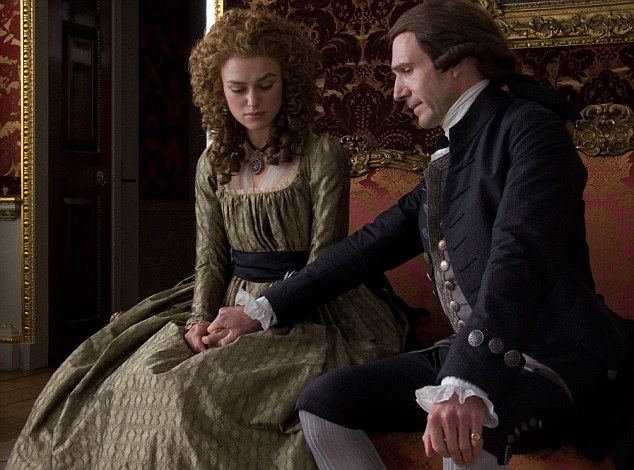
---Georgiana, 5th Duchess of Devonshire, recently portrayed on film by Keira Knightley (pictured here with Ralph Fiennes as the Duke of Devonshire in the 2008 film The Duchess), personally witnessed Mrs Fitzherbert's agreement to marry the desperate prince Read more: http://www.dailymail.co.uk/news/article
And they dressed. The Prince possessed a handsome florid face, a splendid, if slightly plump figure, and first-class legs, of which he was inordinately proud. He was even prouder of his taste in clothes, formed and guided by his friend Beau Brummell, who had revolutionized the Englishman’s dress by insisting on subdued colors, perfect cut, and exquisite linen as the marks of elegance. Only in the evening, on full-dress occasions, were princes and nobles permitted to dress like peacocks. But clothes and the wearing of them was a matter for daily concern and long discussion.
Princes and their friends , after settling on a place like a cloud of butterflies often gorge themselves on its nectar and then flutter away to stimulate their appetites in fresh pastures. This time, however, fate riveted the Prin
o Brighton. He fell in love with a dangerously unusual widow-Mrs. Fitzherbert. Mrs. Fitzherbert was a Roman Catholic- pious, virtuous, very comely. She neither welcomed the Prince’s attentions nor responded to his ardor. She preferred to be left alone. The Prince’s siege grew hectic: he swore, he cajoled, he promised; presents rained on her, letters pursued her, finally marriage trapped her. Conducted in utmost secrecy, it was, of course, illegal.
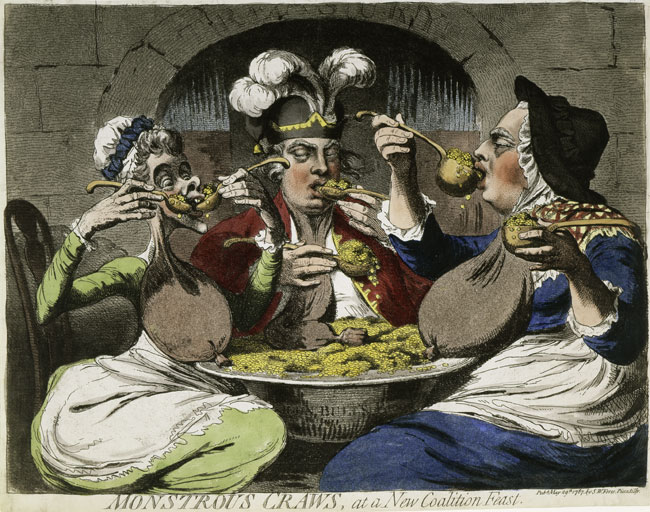
Gillray comments on a temporary “truce” in the ongoing conflict between the King and Queen, and the Prince of Wales, over the Prince’s debts. The Prime Minister, William Pitt, brought about this brief reconciliation when he recommended that Parliament use public funds to settle the Prince’s debts and increase his annual income. The King, Queen, and Prince (in the center) gorge on moneys extracted from Britain’s citizens (“John Bull’s Blood”), though the Queen, one of Gillray’s favorite targets, seems the most avaricious. Their “craws” allude to an exhibition in London in 1787 of “three Wild-born human beings ...
No prince of the British royal family could marry without the sovereign’s consent; no consent could have been forthcoming from George III for a marriage to a Roman Catholic widow. On the Prince’s part the ceremony was a meaningless folly; on hers, the necessary religious sanction to her bedding with the Prince. In Mrs. Fitzherbert’s eyes, and in the eyes of her church and her fellow believers, the Prince was her husband. In English law, she could be nothing but his mistress. The Prince of course, flaunted his conquest but strenuously denied, even to a friend as close as Charles James Fox, the method by which he had achieved it.

Getty Images. Brighton Pavilion."circa 1825: The oriental domes of Brighton Pavilion in Sussex, the pleasure palace of King George IV. (Photo by Hulton Archive/Getty Images) "
Nevertheless, rumors reverberated, and George III, never a man of easy temper, regarded his son with so prejudiced an eye that he left him to marinate in his debts. During his frantic courtship the Prince, according to Lord Holland, had rolled in grief on Charles James Fox’s floor, crying by the hour and “swearing that he would abandon the country, forgo the crown, sell his jewels, and scrape together a competence to fly with her to America.” Instead of which, once wed, he drove off in an ostentatious austerity to Brighton and installed Mrs. Fitzherbert conveniently near the farmhouse that he had begun to regard as his own.
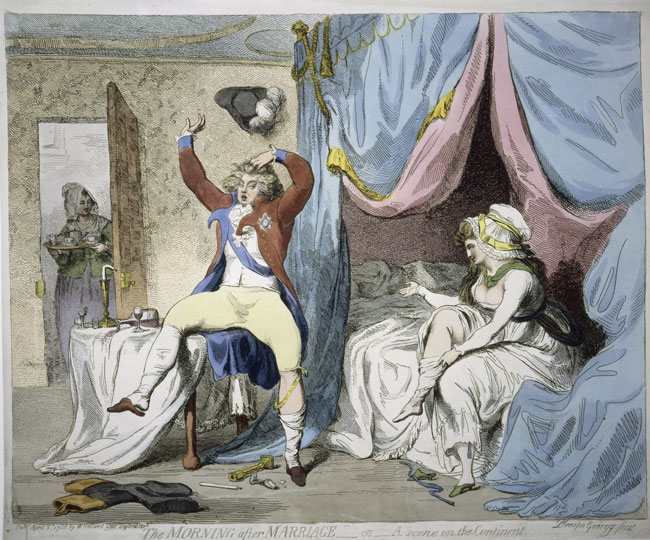
---The Prince of Wales’s romantic entanglement with a twice-widowed, Roman Catholic commoner, Mrs. Maria Anne Smythe Fitzherbert, was the talk of the town and a print shop obsession in 1786. In December 1785, the Prince apparently wed Mrs. Fitzherbert in a secret marriage, portrayed fancifully by Gillray in a 1786 print, which was reissued in 1788, followed a week later by this satire. Borrowing the pose of the bored wife from Hogarth’s Marriage à la Mode, with all its implied associations, Gillray shows the Prince as exhausted from his marital exertions (witness the spent candle and spilt wine), while Mrs. Fitzherbert, in the pose of a prostitute in Hogarth’s A Rake’s Progress, looks invitingly at the unmade bed. The union was, in fact, invalid since the Prince needed and had not obtained the King’s consent, while marriage to a Catholic would have blocked his succession to the throne. ---
As soon a Parliament accepted the denials of the Prince’s friends about his marriage, persuaded the King to grant him 10,000 more a year and to settle his debts, the Prince was able to devote himself to love, architecture, and interior decoration which, with food, drink and music were to be the obsessions of his life. For more than forty years he pursued all of them at the Pavilion that he built for himself at Brighton, or rather, that he went on building at Brighton, for like all compulsive builders and decorators, the Prince was never finished.
Indeed, when the Pavilion was at last completed, the Prince, by the King George IV, lost interest in it and gave his attention to Windsor, where, with both the Castle and the Royal Lodge on his hands, he could fully occupy both his old age and his regal income.








 COMMENTS
COMMENTS



